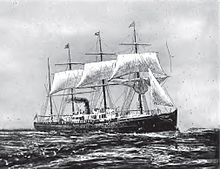RMS Oceanic (ship, 1871)
|
||||||||||||||||||||||
|
||||||||||||||||||||||
|
||||||||||||||||||||||
|
||||||||||||||||||||||
|
||||||||||||||||||||||
|
||||||||||||||||||||||
The RMS Oceanic (I) was the first passenger ship of the British shipping company White Star Line, put into service in 1871 . The Oceanic was built for the transatlantic passenger traffic between Liverpool and New York and set new standards in the North Atlantic passenger traffic.
The ship
The 3707 GRT steamship RMS Oceanic was built by Harland & Wolff in Belfast , Northern Ireland and was launched on August 27, 1870. The 128.01 meter long and 12.46 meter wide, iron- built passenger and mail ship was the first of four sister ships with which the young White Star Line opened its passenger and mail services between Great Britain and North America . The Oceanic was powered by a combination of steam and sailing power. It had twelve steam boilers and a four-cylinder compound steam engine, which together acted on a single screw and could enable a maximum speed of 14.5 knots . In addition, the ship was equipped with four masts with full rigging . The modern passenger accommodations offered space for 166 first class passengers and 1000 third class passengers.

One of the innovations was that the first class rooms were located amidships in order to be as far away as possible from the engine noise and the screw vibrations. The first class dining room, 24 meters long and 12 meters wide, was large enough to accommodate all first class travelers at the same time. The portholes were much larger than on other ships at the time and let more daylight into the rooms. Almost all of the first-class cabins had running water . There were also electrically operated bells to call the steward .
The sister ships of the Oceanic were the RMS Atlantic (1871), the RMS Baltic (I) (1871) and the RMS Republic (I) (1872), all of which measured around 3700 GRT and all had the same structural features. With the construction of the four ships, the Harland & Wolff shipyard was committed without a contract being concluded between the two parties. The only condition of the White Star Line was that the ships should always be more comfortable and luxurious. This formed the approach that the shipping company followed in the following decades. The White Star Line did not set any cost limits for the construction of the Oceanic . The ship was quickly referred to as the “royal yacht ” by the contemporary press , as with her long, elegant hull she looked more like an ocean yacht than an ocean liner. A railing had taken the place of a high bulwark , giving passengers a clear view of the ocean. The hull was divided into eleven watertight compartments by ten bulkheads .
period of service
The RMS Oceanic was the first of the four ships to be completed. She arrived in Liverpool on February 26, 1871 after its completion , from where she set sail on March 2, 1871 with only 64 passengers on board under the command of Sir Digby Murray on her maiden voyage via Queenstown to New York . Because of the overheated boiler, the ship had to enter Holyhead and shortly afterwards return to Liverpool. The journey was resumed on March 14th. On March 28, 1871, the Oceanic first arrived in New York. In January 1872, the ship underwent an overhaul, with the front deck being enlarged so that the bow could not easily submerge in heavy seas. In addition, two additional boilers were installed to increase the drive and thus the machine output. The masts were also shortened.
On March 11, 1875, the Oceanic set out on her last voyage from Liverpool to New York. Then she was chartered to the Occidential & Oriental Steamship Company. The White Star Line continued to provide the officers , while the Chinese were now used as the crew. The ship continued to wear the White Star Line colors but the Occidental flag. From then on the ship went from San Francisco to Yokohama and Hong Kong and back. On the first voyage to Hong Kong, the Oceanic set a new speed record for this route. In December 1876 a new record was added on the route from Yokohama to San Francisco, which she beat again in November 1889 with a time of 13 days, 14 hours and 5 minutes.
On August 22, 1888, the Oceanic collided at Fort Point in the fog with the coastal liner ("Coastal Liner") City of Chester (1106 GRT), which went down with the loss of 16 people. In 1895 it was returned to the White Star Line, which wanted to put it back into service. It was sent to Harland & Wolff for modernization in Belfast, but the necessary inspections showed that an overhaul would not be profitable. So she was sold for demolition and left Belfast on February 10, 1896 in tow. Shortly thereafter, the Oceanic was scrapped in a demolition yard on the Thames .
literature
- Rook, Hans-Joachim: The hunt for the blue ribbon . Shipowners, races and records. Gondrom Verlag GmbH & Co. KG, Bindlach 1994, ISBN 3-8112-1187-0 .
